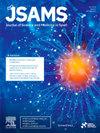Passive hamstring muscles rigidity throughout the menstrual cycle and the effect of oral contraception
IF 3
2区 医学
Q1 SPORT SCIENCES
引用次数: 0
Abstract
Objectives
Female athletes have a lower risk of hamstring strain injuries than males. The variations in oestradiol and progesterone concentrations happening during the menstrual cycle and oral contraceptive use may influence muscle mechanical properties, potentially affecting muscle injury risk. However, to date, no study has combined an assessment of hamstring muscles' mechanical properties spread over the full knee range of motion with rigorous hormonal control of the menstrual cycle, electromyographic monitoring and inclusion of oral contraceptive users. The present study aims to be the first to rigorously evaluate the association between menstrual cycle, oral contraceptive use and hamstring muscles' mechanical properties.
Design
Cross-sectional study with repeated measures.
Methods
Shear wave elastography measurements were performed at three different times during the menstrual and oral contraceptive cycle. Hormonal assessment and electromyographic monitoring were also carried out.
Results
No difference in hamstring muscles' shear wave speed, anatomical cross-sectional area, knee joint musculoarticular stiffness and maximal range of motion were observed along the menstrual cycle despite the presence of the expected variations in ovarian steroid hormones concentrations. No difference in these parameters was also reported throughout the oral contraception use.
Conclusions
No differences in the mechanical properties of the hamstring muscles were observed, whether the concentrations of ovarian steroid hormones fluctuate with the menstrual cycle or remain stable with oral contraceptive use, despite the notable effects of these hormones on the muscle composition.
被动腘绳肌强直贯穿月经周期及口服避孕药的效果。
目的:女运动员腿筋拉伤的风险比男运动员低。在月经周期和口服避孕药期间发生的雌二醇和黄体酮浓度的变化可能影响肌肉的机械特性,潜在地影响肌肉损伤的风险。然而,到目前为止,还没有研究将腿筋肌肉在整个膝关节运动范围内的机械性能评估与严格的月经周期激素控制、肌电图监测和口服避孕药使用者结合起来。目前的研究旨在成为第一个严格评估月经周期、口服避孕药使用和腿筋肌肉力学性能之间关系的研究。设计:采用重复测量的横断面研究。方法:在月经周期和口服避孕药周期的三个不同时间进行横波弹性测量。同时进行激素评估和肌电图监测。结果:尽管卵巢类固醇激素浓度存在预期的变化,但在月经周期中,腘绳肌的剪切波速度、解剖横截面积、膝关节肌肉关节刚度和最大运动范围均无差异。在口服避孕药的整个使用过程中,这些参数也没有差异。结论:尽管卵巢类固醇激素对肌肉组成有显著影响,但无论卵巢类固醇激素浓度随月经周期波动还是口服避孕药保持稳定,均未观察到腘绳肌的力学性能有差异。
本文章由计算机程序翻译,如有差异,请以英文原文为准。
求助全文
约1分钟内获得全文
求助全文
来源期刊
CiteScore
7.40
自引率
10.00%
发文量
198
审稿时长
48 days
期刊介绍:
The Journal of Science and Medicine in Sport is the official journal of Sports Medicine Australia (SMA) and is an an international refereed research publication covering all aspects of sport science and medicine.
The Journal considers for publication Original research and Review papers in the sub-disciplines relating generally to the broad sports medicine and sports science fields: sports medicine, sports injury (including injury epidemiology and injury prevention), physiotherapy, podiatry, physical activity and health, sports science, biomechanics, exercise physiology, motor control and learning, sport and exercise psychology, sports nutrition, public health (as relevant to sport and exercise), and rehabilitation and injury management. Manuscripts with an interdisciplinary perspective with specific applications to sport and exercise and its interaction with health will also be considered.

 求助内容:
求助内容: 应助结果提醒方式:
应助结果提醒方式:


